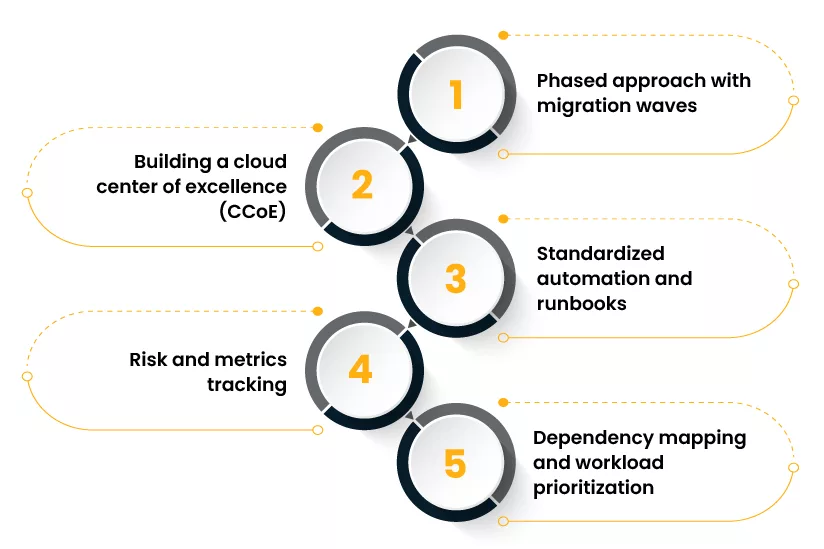Every enterprise migration journey has its own challenges. But time and again, teams that follow repeatable structures see much higher success. In this post, I share proven AWS migration services and success patterns that consistently lead to better outcomes. You’ll see how aligning technical execution with business goals matters, and real-life case examples to ground the concepts.
What business problems are we solving?
- Enterprises often struggle with cost overruns, delayed timelines, or technical debt during cloud migrations.
- Many migration failures come from gaps in planning, missing stakeholder alignment, or insufficient readiness.
- The goal is to raise the success rate of migrations by applying repeatable, tested approaches.
Highlight repeatable success patterns

Here are some core patterns that professional teams use to increase probability of positive outcomes:
1. Phased approach with migration waves
- Breaking a large migration into manageable waves helps reduce risk, a key phased cloud migration approach proven in enterprise transformations.
- Early waves serve as pilots to refine processes, tooling, runbooks.
- Later waves benefit from lessons learned, reducing errors or surprises.
2. Building a cloud center of excellence (CCoE)
- A dedicated cloud center of excellence ensures consistency, governance, and shared learnings across migration projects.
- It acts as a repository of knowledge, templates, runbooks, and governance guardrails.
- This helps maintain repeatability, quality, and standards across migration projects.
3. Standardized automation and runbooks
- Automating environment provisioning, workload cutovers, and validation using AWS automation tools reduces manual errors and improves reliability.
- Runbooks codify what was done in earlier migrations — checks, rollback steps, test scripts.
- Once automated, runbooks can be reused across waves, enhancing reliability and speed.
4. Risk and metrics tracking
- Defining clear metrics (KPIs) for each workload: downtime tolerance, performance thresholds, cost budgets, compliance.
- Monitoring risk factors like dependencies, legacy constraints, licensing.
- Tracking progress, deviations, and applying corrective actions ensures steady progress.
5. Dependency mapping and workload prioritization
- Mapping dependencies between applications, data stores, network flows allows smarter migration sequencing.
- Prioritizing low-risk workloads first helps build confidence, prove value, and refine processes.
- High-dependency or legacy workloads are scheduled later with special tactics.
Takeaway: These patterns form the backbone of robust migration programs. They are not ad-hoc; they are repeatable. When used diligently, they contribute strongly to achieving AWS migration success patterns that drive predictable and efficient migrations.
Why do repeatable patterns matter?
Cloud migrations fail less because of technical gaps and more because of inconsistent planning. Each enterprise has its own architecture, legacy systems, and business priorities, but the forces driving success are surprisingly uniform. Teams that document their approach, measure progress, and reuse what works tend to avoid costly rework.
Repeatable patterns build organizational memory. They let teams capture lessons from one project and apply them to the next. Over time, these patterns evolve into an internal migration playbook, a guide that speeds up every future initiative.
In AWS environments, these playbooks often blend technical tooling with operational discipline: automation pipelines, governance structures, dependency mapping, and stakeholder communication. When applied consistently, they create predictable pathways to success.
Align technical execution with business goals
Technical migrations cannot live in isolation. Aligning the migration project with business objectives is vital. Here are ways to align:
Defining clear business drivers
- Clarify why you are migrating: cost savings, agility, performance improvements, regulatory compliance.
- Translate those drivers into measurable targets: cost reduction, faster deployments, better reliability.
Using migration frameworks
- Applying a structured framework ensures all perspectives are addressed. For example, the AWS Prescriptive Guidance documentation suggests using governance, people, platform, security, operations, and business perspectives to assess readiness.
- These AWS migration frameworks capture non-technical aspects like compliance, people, and change management to support transformation goals.
Setting up tooling & governance
- Create guardrails through AWS landing zone setup and account structures to enforce governance and cost control. The AWS Well‑Architected Tool offers a migration lens that integrates technical pillars like security, cost optimization, reliability, operations, etc.
- Governance ensures workloads follow standards and compliance requirements while being migrated.
Translating metrics into stakeholder value
- Show business units how migration will impact their KPIs: faster feature delivery, lower operational overhead, scalability, risk mitigation.
- Use baseline metrics (on-premises or legacy environment) and compare against target cloud environment to show uplift.
Continuous improvement loop
- After each wave, review outcomes vs business targets.
- Adjust scope, tools, or processes to better align subsequent migration waves with business goals.
Takeaway: The best results occur when technical planning is not decoupled from business goals. Combining structured migration frameworks and clear stakeholder alignment helps ensure each workload delivers value, not just moved servers.
Migration Pattern
- Assess phase: evaluate business & technical readiness, map dependencies, define metrics.
- Mobilize: build landing zones, establish governance, create runbooks, prepare teams (CCoE).
- Migrate waves: execute waves of workloads, apply automation, test & validate.
- Modernize & optimize: refine performance, cost, compliance, and business value.
- Feedback loop: review outcomes vs KPIs and refine next waves.
Frequently Asked Questions (FAQ)
Q: What is meant by “AWS migration success patterns”?
A: These refer to recurring approaches and practices that have been proven across multiple migration projects to increase success rates. They include phased migrations, dependency mapping, automation, metrics tracking, and establishing dedicated teams (CCoE).
Q: How do migration frameworks help in migration projects?
A: Frameworks provide structured guidance covering both technical and non-technical perspectives: business, governance, people, platform, operations, security, etc. They help ensure no critical dimension is missed.
Q: What are some best practices for cloud migration?
A: Some of the best practices are: performing readiness assessments, using pilot migrations, automating provisioning, defining performance metrics, ensuring compliance, and continuously improving based on learnings from earlier waves.
Q: How can cloud project delivery be improved in migration programs?
A: By using clear planning, governance, automation, repeatable processes, dependency management, and aligning each migration wave with business metrics. That helps control risks, enforce standards, and deliver predictable outcomes.
Conclusion
Applying AWS migration success patterns consistently makes the difference between a troubled migration and one that meets or exceeds expectations. The patterns described above are not theoretical ideals: they are distilled from large-scale enterprise projects. When you connect technical migration phases to business goals, use well designed migration frameworks, follow best practices, and treat migration as a disciplined cloud project delivery, you set yourself up for repeatable success.
If you apply these approaches and learn from pilot waves, you will reduce risk, meet stakeholder KPIs, and complete migrations more reliably.











